|
NN 42 |
3111 |
|
|
R-PLR |
|
106 - Natural History Museum UK (?) |
|
|
|
Auffenberg, W. 1981. The fossil turtles of Olduvai Gorge, Tanzania, Africa. Copeia 1981:509-522. |
|
152 - W. Auffenberg |
|
|
Unknown |
|
Reptilia |
Testudines |
Cryptodira |
|
Testidinoidea |
Testudinidae |
|
|
Geochelone |
sp. |
|
The author puts this specimen in Geochelone, species B. |
No |
|
F558 |
6848 |
|
|
CARA-f, NRL-f |
|
106 - Natural History Museum UK (?) |
|
|
|
-- |
The authors say this specimen comes from "SI" though this is not a known locality. |
152 - W. Auffenberg |
|
|
Unknown |
|
Reptilia |
Testudines |
Cryptodira |
|
Testidinoidea |
Testudinidae |
|
|
Geochelone |
sp. |
|
The author puts this specimen in Geochelone, species B. |
No |
|
MW 49/136 |
3110 |
|
|
PERI-f |
|
106 - Natural History Museum UK (?) |
|
|
|
Auffenberg, W. 1981. The fossil turtles of Olduvai Gorge, Tanzania, Africa. Copeia 1981:509-522. |
|
152 - W. Auffenberg |
|
|
Unknown |
|
Reptilia |
Testudines |
Cryptodira |
|
Testidinoidea |
Testudinidae |
|
|
Geochelone |
pardalis |
|
The author mentions there are over 3,000 fossilized turtle fragments from Olduvai Gorge, 98% of which are from the species Pelusios sinuatus. However, it is unclear which specimens belong to which species based on the description given. When it was unclear, the specimen is only referred to as belonging to the Order Testudines. |
No |
|
MW 49/136 |
6877 |
|
|
PERI-f |
|
106 - Natural History Museum UK (?) |
|
|
|
Auffenberg, W. 1981. The fossil turtles of Olduvai Gorge, Tanzania, Africa. Copeia 1981:509-522. |
|
152 - W. Auffenberg |
|
|
Unknown |
|
Reptilia |
Testudines |
Cryptodira |
|
Testidinoidea |
Testudinidae |
|
|
Geochelone |
pardalis |
|
The author mentions there are over 3,000 fossilized turtle fragments from Olduvai Gorge, 98% of which are from the species Pelusios sinuatus. However, it is unclear which specimens belong to which species based on the description given. When it was unclear, the specimen is only referred to as belonging to the Order Testudines. |
No |
|
OVPP-Testudines 15 |
6853 |
18 - VEK |
|
SHEL-f |
|
106 - Natural History Museum UK (?) |
|
|
|
-- |
|
152 - W. Auffenberg |
|
|
Unknown |
|
Reptilia |
Testudines |
|
|
|
|
|
|
|
|
|
The author mentions there are over 3,000 fossilized turtle fragments from Olduvai Gorge, 98% of which are from the species Pelusios sinuatus. However, it is unclear which specimens belong to which species based on the description given. When it was unclear, the specimen is only referred to as belonging to the Order Testudines. |
No |
|
F6250 |
6852 |
69 - GRK S |
|
CARA, PLAS-f |
|
106 - Natural History Museum UK (?) |
|
|
|
-- |
|
152 - W. Auffenberg |
|
|
Unknown |
|
Reptilia |
Testudines |
|
|
|
|
|
|
|
|
|
The author mentions there are over 3,000 fossilized turtle fragments from Olduvai Gorge, 98% of which are from the species Pelusios sinuatus. However, it is unclear which specimens belong to which species based on the description given. When it was unclear, the specimen is only referred to as belonging to the Order Testudines. |
No |
|
NN42 |
6847 |
|
|
CARA-f |
|
106 - Natural History Museum UK (?) |
|
|
|
-- |
The authors say this specimen comes from "NN" though this is not a known locality. Perhaps it comes from FLK NN. |
152 - W. Auffenberg |
|
|
Unknown |
|
Reptilia |
Testudines |
|
|
|
|
|
|
|
|
|
The author mentions there are over 3,000 fossilized turtle fragments from Olduvai Gorge, 98% of which are from the species Pelusios sinuatus. However, it is unclear which specimens belong to which species based on the description given. When it was unclear, the specimen is only referred to as belonging to the Order Testudines. |
No |
|
OVPP-Testudines 12 |
6846 |
|
|
CARA, PLAS |
|
106 - Natural History Museum UK (?) |
|
|
|
-- |
|
152 - W. Auffenberg |
|
|
Unknown |
|
Reptilia |
Testudines |
|
|
|
|
|
|
|
|
|
The author mentions there are over 3,000 fossilized turtle fragments from Olduvai Gorge, 98% of which are from the species Pelusios sinuatus. However, it is unclear which specimens belong to which species based on the description given. When it was unclear, the specimen is only referred to as belonging to the Order Testudines. |
No |
|
F6647 |
3105 |
8 - MK |
|
SHEL-f |
|
106 - Natural History Museum UK (?) |
IV |
|
|
-- |
|
152 - W. Auffenberg |
|
|
Unknown |
|
Reptilia |
Testudines |
|
|
|
|
|
|
|
|
|
The author mentions there are over 3,000 fossilized turtle fragments from Olduvai Gorge, 98% of which are from the species Pelusios sinuatus. However, it is unclear which specimens belong to which species based on the description given. When it was unclear, the specimen is only referred to as belonging to the Order Testudines. |
No |
|
F42 |
3049 |
6 - FLK NN |
|
PLR |
|
106 - Natural History Museum UK (?) |
I |
|
|
Auffenberg, W. 1981. The fossil turtles of Olduvai Gorge, Tanzania, Africa. Copeia 1981:509-522. |
|
152 - W. Auffenberg |
|
|
Unknown |
|
Reptilia |
Testudines |
|
|
|
|
|
|
|
|
|
The author mentions there are over 3,000 fossilized turtle fragments from Olduvai Gorge, 98% of which are from the species Pelusios sinuatus. However, it is unclear which specimens belong to which species based on the description given. When it was unclear, the specimen is only referred to as belonging to the Order Testudines. |
No |
|
OVPP-Testudines 12 |
3079 |
|
|
CARA, PLAS |
|
106 - Natural History Museum UK (?) |
|
|
|
-- |
|
152 - W. Auffenberg |
|
|
Unknown |
|
Reptilia |
Testudines |
|
|
|
|
|
|
|
|
|
The author mentions there are over 3,000 fossilized turtle fragments from Olduvai Gorge, 98% of which are from the species Pelusios sinuatus. However, it is unclear which specimens belong to which species based on the description given. When it was unclear, the specimen is only referred to as belonging to the Order Testudines. |
No |
|
NN42 |
3080 |
|
|
CARA-f |
|
106 - Natural History Museum UK (?) |
|
|
|
-- |
The authors say this specimen comes from "NN" though this is not a known locality. Perhaps it comes from FLK NN. |
152 - W. Auffenberg |
|
|
Unknown |
|
Reptilia |
Testudines |
|
|
|
|
|
|
|
|
|
The author mentions there are over 3,000 fossilized turtle fragments from Olduvai Gorge, 98% of which are from the species Pelusios sinuatus. However, it is unclear which specimens belong to which species based on the description given. When it was unclear, the specimen is only referred to as belonging to the Order Testudines. |
No |
|
F84 |
3083 |
11 - HWK |
|
PERI |
|
106 - Natural History Museum UK (?) |
II |
|
|
-- |
|
152 - W. Auffenberg |
|
|
Unknown |
|
Reptilia |
Testudines |
|
|
|
|
|
|
|
|
|
The author mentions there are over 3,000 fossilized turtle fragments from Olduvai Gorge, 98% of which are from the species Pelusios sinuatus. However, it is unclear which specimens belong to which species based on the description given. When it was unclear, the specimen is only referred to as belonging to the Order Testudines. |
No |
|
F6250 |
3085 |
69 - GRK S |
|
CARA, PLAS-f |
|
106 - Natural History Museum UK (?) |
|
|
|
-- |
|
152 - W. Auffenberg |
|
|
Unknown |
|
Reptilia |
Testudines |
|
|
|
|
|
|
|
|
|
The author mentions there are over 3,000 fossilized turtle fragments from Olduvai Gorge, 98% of which are from the species Pelusios sinuatus. However, it is unclear which specimens belong to which species based on the description given. When it was unclear, the specimen is only referred to as belonging to the Order Testudines. |
No |
|
OVPP-Testudines 15 |
3086 |
18 - VEK |
|
SHEL-f |
|
106 - Natural History Museum UK (?) |
|
|
|
-- |
|
152 - W. Auffenberg |
|
|
Unknown |
|
Reptilia |
Testudines |
|
|
|
|
|
|
|
|
|
The author mentions there are over 3,000 fossilized turtle fragments from Olduvai Gorge, 98% of which are from the species Pelusios sinuatus. However, it is unclear which specimens belong to which species based on the description given. When it was unclear, the specimen is only referred to as belonging to the Order Testudines. |
No |
|
OVPP-Testudines 16 |
3087 |
70 - EHK |
|
SHEL-f |
|
106 - Natural History Museum UK (?) |
I |
|
|
-- |
|
152 - W. Auffenberg |
|
|
Unknown |
|
Reptilia |
Testudines |
|
|
|
|
|
|
|
|
|
The author mentions there are over 3,000 fossilized turtle fragments from Olduvai Gorge, 98% of which are from the species Pelusios sinuatus. However, it is unclear which specimens belong to which species based on the description given. When it was unclear, the specimen is only referred to as belonging to the Order Testudines. |
No |
|
OVPP-Testudines 17 |
3088 |
9 - THC |
|
SHEL-f |
|
106 - Natural History Museum UK (?) |
I |
|
|
-- |
|
152 - W. Auffenberg |
|
|
Unknown |
|
Reptilia |
Testudines |
|
|
|
|
|
|
|
|
|
The author mentions there are over 3,000 fossilized turtle fragments from Olduvai Gorge, 98% of which are from the species Pelusios sinuatus. However, it is unclear which specimens belong to which species based on the description given. When it was unclear, the specimen is only referred to as belonging to the Order Testudines. |
No |
|
OVPP-Testudines 18 |
3095 |
22 - SC |
|
SHEL-f |
|
106 - Natural History Museum UK (?) |
II |
|
|
-- |
|
152 - W. Auffenberg |
|
|
Unknown |
|
Reptilia |
Testudines |
|
|
|
|
|
|
|
|
|
The author mentions there are over 3,000 fossilized turtle fragments from Olduvai Gorge, 98% of which are from the species Pelusios sinuatus. However, it is unclear which specimens belong to which species based on the description given. When it was unclear, the specimen is only referred to as belonging to the Order Testudines. |
No |
|
F556 |
3101 |
8 - MK |
|
SHEL-f |
|
106 - Natural History Museum UK (?) |
IV |
|
|
-- |
|
152 - W. Auffenberg |
|
|
Unknown |
|
Reptilia |
Testudines |
|
|
|
|
|
|
|
|
|
The author mentions there are over 3,000 fossilized turtle fragments from Olduvai Gorge, 98% of which are from the species Pelusios sinuatus. However, it is unclear which specimens belong to which species based on the description given. When it was unclear, the specimen is only referred to as belonging to the Order Testudines. |
No |
|
F565 |
3102 |
8 - MK |
|
SHEL-f |
|
106 - Natural History Museum UK (?) |
IV |
|
|
-- |
|
152 - W. Auffenberg |
|
|
Unknown |
|
Reptilia |
Testudines |
|
|
|
|
|
|
|
|
|
The author mentions there are over 3,000 fossilized turtle fragments from Olduvai Gorge, 98% of which are from the species Pelusios sinuatus. However, it is unclear which specimens belong to which species based on the description given. When it was unclear, the specimen is only referred to as belonging to the Order Testudines. |
No |
|
F57 |
3103 |
8 - MK |
|
SHEL-f |
|
106 - Natural History Museum UK (?) |
IV |
|
|
-- |
|
152 - W. Auffenberg |
|
|
Unknown |
|
Reptilia |
Testudines |
|
|
|
|
|
|
|
|
|
The author mentions there are over 3,000 fossilized turtle fragments from Olduvai Gorge, 98% of which are from the species Pelusios sinuatus. However, it is unclear which specimens belong to which species based on the description given. When it was unclear, the specimen is only referred to as belonging to the Order Testudines. |
No |
|
F645 |
3104 |
8 - MK |
|
SHEL-f |
|
106 - Natural History Museum UK (?) |
IV |
|
|
-- |
|
152 - W. Auffenberg |
|
|
Unknown |
|
Reptilia |
Testudines |
|
|
|
|
|
|
|
|
|
The author mentions there are over 3,000 fossilized turtle fragments from Olduvai Gorge, 98% of which are from the species Pelusios sinuatus. However, it is unclear which specimens belong to which species based on the description given. When it was unclear, the specimen is only referred to as belonging to the Order Testudines. |
No |
|
M. 14517 |
728 |
|
|
L-HOR-f |
1931 |
106 - Natural History Museum UK (?) |
I |
|
|
Gentry, A. W., and Gentry, A. 1978. Fossil Bovidae (Mammalia) of Olduvai Gorge, Tanzania. Part I. Bulletin of the British Museum (Natural History): Geology 29:289-446. |
|
137 - A. Gentry |
|
|
Unknown |
|
Mammalia |
Artiodactyla |
Ruminantia |
|
Bovoidea |
Bovidae |
Bovinae |
Tragelaphini |
Tragelaphus |
|
|
The author indicates this kudu specimen is too fragmented to be assigned to subspecies. |
No |
|
M. 21479 |
729 |
|
|
L-HOR-f |
|
106 - Natural History Museum UK (?) |
|
|
|
Gentry, A. W., and Gentry, A. 1978. Fossil Bovidae (Mammalia) of Olduvai Gorge, Tanzania. Part I. Bulletin of the British Museum (Natural History): Geology 29:289-446. |
|
137 - A. Gentry |
|
|
Unknown |
|
Mammalia |
Artiodactyla |
Ruminantia |
|
Bovoidea |
Bovidae |
Bovinae |
Tragelaphini |
Tragelaphus |
|
|
The author indicates this kudu specimen is too fragmented to be assigned to subspecies. |
No |
|
M. 21480 |
730 |
|
|
HOR-f |
1931 |
106 - Natural History Museum UK (?) |
|
|
|
Gentry, A. W., and Gentry, A. 1978. Fossil Bovidae (Mammalia) of Olduvai Gorge, Tanzania. Part I. Bulletin of the British Museum (Natural History): Geology 29:289-446. |
|
137 - A. Gentry |
|
|
Unknown |
|
Mammalia |
Artiodactyla |
Ruminantia |
|
Bovoidea |
Bovidae |
Bovinae |
Tragelaphini |
Tragelaphus |
|
|
The author indicates this kudu specimen is too fragmented to be assigned to subspecies. |
No |
|
M. 21481 |
731 |
|
|
R-HOR-f |
|
106 - Natural History Museum UK (?) |
|
|
|
Gentry, A. W., and Gentry, A. 1978. Fossil Bovidae (Mammalia) of Olduvai Gorge, Tanzania. Part I. Bulletin of the British Museum (Natural History): Geology 29:289-446. |
|
137 - A. Gentry |
|
|
Unknown |
|
Mammalia |
Artiodactyla |
Ruminantia |
|
Bovoidea |
Bovidae |
Bovinae |
Tragelaphini |
Tragelaphus |
|
|
The author indicates this kudu specimen is too fragmented to be assigned to subspecies. |
No |
|
OH 2 |
3718 |
27 - MNK |
279 - 88 |
CRA-f |
1935 |
106 - Natural History Museum UK (?) |
III/IV |
Lowest horizon of Bed IVa. |
Surface. Found at head of MNK Gully where Beds II and IV are exposed. |
Leakey MD. (1971) Olduvai Gorge, Vol. 3: excavations in Beds I & II 1960-1963. New York, NY: Cambridge University Press. |
Two cranial vault fragments. Specimen previously housed at National Museum of Kenya. Not found at House of Culture, Dar es Salaam, Tanzania. |
142 - M. D. Leakey |
|
264 - Leakey family expedition |
No |
|
Mammalia |
Primates |
Anthropoidea |
Haplorhini |
Hominoidea |
Hominidae |
Homininae |
Hominini |
Homo |
erectus |
|
Similar to OH 9 and OH 12. |
No |
|
M. 14683 |
10383 |
|
|
Two upper tusks, probably of the same individual. |
1934 |
106 - Natural History Museum UK (?) |
I |
lower part, Middle Pleistocene |
Kamasian Pluvial |
LSB Leakey. 1958. Fossil Mammals of Africa: Some East African Pleistocene Suidae. British Museum. No. 14. |
British Museum Palaeontology Department |
130 - L.S.B. Leakey |
1942 |
|
Unknown |
|
Mammalia |
Artiodactyla |
Suiformes |
|
Suoidea |
Suidae |
|
|
Potamochoerus |
majus |
|
Paratypes. Originally classified as Koiropotamus majus (Hopwood, 1934). Reclassified as Potamochoerus majus (Leakey, 1942). |
Yes |
|
M. 14683 |
1345 |
|
|
R/L-, TUSK |
|
106 - Natural History Museum UK (?) |
I |
|
|
Hopwood, A. 1934. New fossil mammals from Olduvai, Tanganyika territory. Annals of the Magazine of Natural History. 10: 546-550. |
Two tusks, which are probably from the same individual represent the two paratypes. |
293 - A.T. Hopwood |
|
|
Unknown |
|
Mammalia |
Artiodactyla |
Suiformes |
|
Suoidea |
Suidae |
|
|
Koiropotamus |
majus |
|
Paratypes |
No |
|
M. 21452 |
900 |
|
|
R-HOR |
1931 |
106 - Natural History Museum UK (?) |
IV |
|
|
Gentry, A. W., and Gentry, A. 1978. Fossil Bovidae (Mammalia) of Olduvai Gorge, Tanzania. Part I. Bulletin of the British Museum (Natural History): Geology 29:289-446. |
|
137 - A. Gentry |
|
|
Unknown |
|
Mammalia |
Artiodactyla |
Ruminantia |
|
Bovoidea |
Bovidae |
Alcelaphinae |
Alcelaphini |
Connochaetes |
taurinus |
olduvaiensis |
paratype? |
No |
|
M. 14685 |
1347 |
|
|
L-MAN-f, L-M |
|
106 - Natural History Museum UK (?) |
II |
|
|
Hopwood, A. 1934. New fossil mammals from Olduvai, Tanganyika territory. Annals of the Magazine of Natural History. 10: 546-550. |
|
293 - A.T. Hopwood |
|
|
Unknown |
|
Mammalia |
Artiodactyla |
Suiformes |
|
Suoidea |
Suidae |
Tetraconodontinae |
|
Notochoerus |
dietrichi |
|
Paratype-�This specimen was referred to as the holotype by Bishop (2010). Bishop also reclassified this sepcimen as Metridiochoerus hopwoodi. |
No |
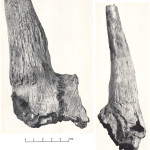 |
M. 14553 |
152 |
|
|
FRO-f, HOR-f |
1931 |
106 - Natural History Museum UK (?) |
II |
|
|
Leakey LSB. 1965. Olduvai Gorge 1951-1961, Volume 1: Fauna and Background. New York, NY: Cambridge University Press. |
This paratype was first described by Schwartz (1937) and is pictured in plate 63. It was excavated by Reck between 1931 and 1935.This specimen is used as the holotype as the original was destroyed in Munich in WWII. |
138 - E. Schwarz |
|
273 - Reck expedition |
No |
|
Mammalia |
Artiodactyla |
Ruminantia |
|
Bovoidea |
Bovidae |
Alcelaphinae |
Alcelaphini |
Damaliscus |
angusticornis |
|
Paratype (Holotype) - This specimen was reclassified by Gentry and Gentry (1978) as Parmularius angusticornis. |
No |
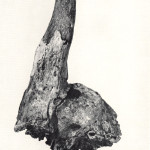 |
M. 21428 |
160 |
18 - VEK |
|
CRA, L/R-HOR-f |
1935 |
106 - Natural History Museum UK (?) |
II |
|
|
Leakey LSB. 1965. Olduvai Gorge 1951-1961, Volume 1: Fauna and Background. New York, NY: Cambridge University Press. |
This specimen is pictured in plates 68 and 69. The specimen has VEK II written on it but it is registered as VEK I. |
138 - E. Schwarz |
|
264 - Leakey family expedition |
Yes |
|
Mammalia |
Artiodactyla |
Ruminantia |
|
Bovoidea |
Bovidae |
Alcelaphinae |
Alcelaphini |
Damaliscus |
angusticornis |
|
Paratype - This specimen was reclassified by Gentry and Gentry (1978) as Parmularius angusticornis. |
No |
|
M. 14948 |
126 |
|
|
CRA-f, L-HOR-f |
|
106 - Natural History Museum UK (?) |
II |
|
|
Leakey LSB. 1965. Olduvai Gorge 1951-1961, Volume 1: Fauna and Background. New York, NY: Cambridge University Press. |
|
130 - L.S.B. Leakey |
|
264 - Leakey family expedition |
Unknown |
|
Mammalia |
Artiodactyla |
Ruminantia |
|
Bovoidea |
Bovidae |
Bovinae |
Bovini |
Bularchus |
arok |
|
Paratype - Gentry and Gentry (1978a) renamed this specimen as P. oldowayensis. |
No |
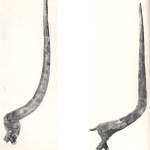 |
M. 21446 |
179 |
|
|
L-HOR-f, CRA-f |
1935 |
106 - Natural History Museum UK (?) |
I |
|
Upper Villafranchian |
Leakey LSB. 1965. Olduvai Gorge 1951-1961, Volume 1: Fauna and Background. New York, NY: Cambridge University Press. |
This specimen is pictured in plate 80. Additional specimens have been found at FLK N I. |
130 - L.S.B. Leakey |
|
264 - Leakey family expedition |
Unknown |
|
Mammalia |
Artiodactyla |
Ruminantia |
|
Bovoidea |
Bovidae |
Alcelaphinae |
Alcelaphini |
Beatragus |
antiquus |
|
Paratype |
No |
|
M. 14686 |
1349 |
|
|
R-MAN, R-P, R-M |
|
106 - Natural History Museum UK (?) |
II |
|
|
Hopwood, A. 1934. New fossil mammals from Olduvai, Tanganyika territory. Annals of the Magazine of Natural History. 10: 546-550. |
The author suggests this specimen is "probably" from Bed II. |
293 - A.T. Hopwood |
|
|
Unknown |
|
Mammalia |
Artiodactyla |
Ruminantia |
|
Giraffoidea |
Giraffidae |
|
|
Helladotherium |
olduvaiensis |
|
Paratype |
No |
|
M. 14687 |
1350 |
|
|
TIB-f, FEM-f, FIB-f |
|
106 - Natural History Museum UK (?) |
I |
|
|
Hopwood, A. 1934. New fossil mammals from Olduvai, Tanganyika territory. Annals of the Magazine of Natural History. 10: 546-550. |
This specimen is described as a "partial hind-limb". Whether it is a tibia, femur, or fibula is unknown. |
293 - A.T. Hopwood |
|
|
Unknown |
|
Mammalia |
Artiodactyla |
Ruminantia |
|
Giraffoidea |
Giraffidae |
|
|
Helladotherium |
olduvaiensis |
|
Paratype |
No |
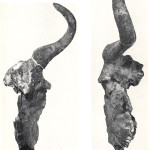 |
M. 21447 |
181 |
23 - TK |
|
CRA, L/R-MAX-f, L-HOR, L/R-P, L/R-M, L/R-I |
1931 |
106 - Natural History Museum UK (?) |
III, IV |
|
4 feet below Masek Beds |
Leakey LSB. 1965. Olduvai Gorge 1951-1961, Volume 1: Fauna and Background. New York, NY: Cambridge University Press. |
This neotype specimen is pictured in plates 81 and 82. The original holotype of M. kattwinkelli (VI-1099) was lost in WWII in Munich. |
130 - L.S.B. Leakey |
|
264 - Leakey family expedition |
Unknown |
|
Mammalia |
Artiodactyla |
Ruminantia |
|
Bovoidea |
Bovidae |
Alcelaphinae |
Alcelaphini |
Xenocephalus |
kattwinkelli |
|
Neotype - This specimen was reclassified by Gentry and Gentry (1978) as Megalotragus kattwinkeli. |
No |
|
M. 14682 |
1344 |
|
|
L-MAN-f, P, M |
1931-32 |
106 - Natural History Museum UK (?) |
IV |
|
|
Hopwood, A. 1934. New fossil mammals from Olduvai, Tanganyika territory. Annals of the Magazine of Natural History. 10: 546-550. |
|
293 - A.T. Hopwood |
|
|
Unknown |
|
Mammalia |
Artiodactyla |
Suiformes |
|
Suoidea |
Suidae |
|
|
Koiropotamus |
majus |
|
Holotype. This specimen was later reclassified as Kolpochoerus majus by Bishop (2010) |
No |
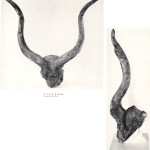 |
M. 21461 |
118 |
13 - RK |
|
CRA, R/L-HOR, R-I, R-P, R-M |
1931 |
106 - Natural History Museum UK (?) |
II |
upper |
|
Leakey LSB. 1965. Olduvai Gorge 1951-1961, Volume 1: Fauna and Background. New York, NY: Cambridge University Press. |
This specimen is pictured in plates 38 and 39. |
130 - L.S.B. Leakey |
|
264 - Leakey family expedition |
Yes |
|
Mammalia |
Artiodactyla |
Ruminantia |
|
Bovoidea |
Bovidae |
Bovinae |
Strepsicerotini |
Strepsiceros |
grandis |
|
Holotype. Gentry and Gentry (1978) reclassified this specimen as Tragelaphus strepsiceros grandis. |
No |




